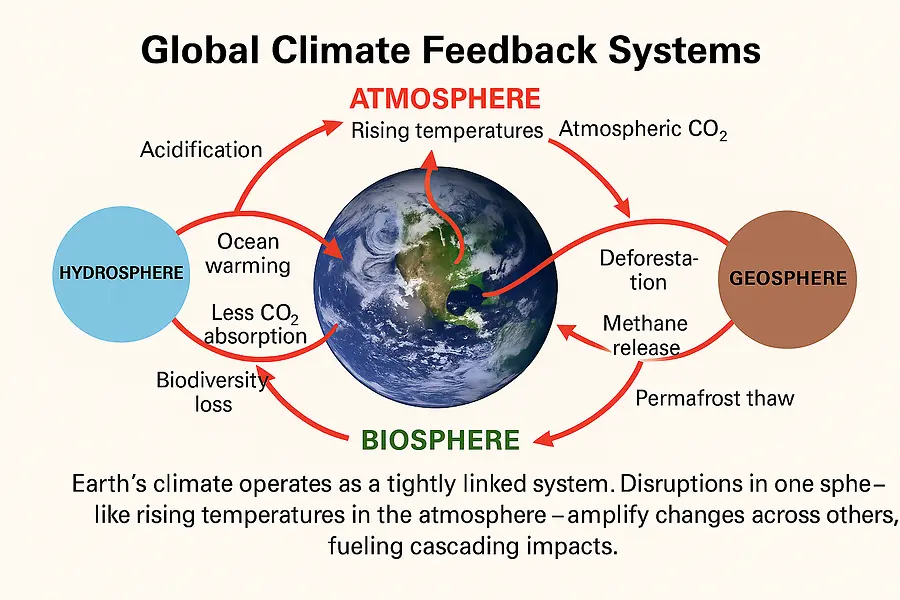Earth's Interconnected Systems in Climate Change
A Web of Accelerating Disruption

A System in Stress
Our Earth is more than a collection of environments—it’s a living, dynamic system of systems. From deep ocean trenches to high mountain glaciers, every part of our planet is woven together. When climate change disturbs one thread, the entire web shudders.
These disruptions are not abstract. They're visible, measurable, and accelerating at a rate that’s overwhelming the Earth’s natural capacity to regulate itself. Understanding this interconnectivity is key to understanding the crisis—and the path forward.
The Four Spheres: One Interconnected Climate System
Earth’s climate depends on four major systems that are always in motion:
- Atmosphere – regulates weather and stores greenhouse gases
- Hydrosphere – includes oceans, rivers, ice, and water vapor
- Biosphere – encompasses all living organisms
- Geosphere – the physical land, rocks, and soil
These systems don’t function in isolation. They interact constantly, exchanging heat, gases, water, and nutrients. The biosphere absorbs atmospheric CO₂. Oceans regulate air temperature. Forests influence rainfall. This is climate in action—an elegant, self-regulating machine that has served us well for eons but is now spiraling out of balance
Human Activity as a Climate Disruptor
The industrial era has pumped billions of tons of carbon dioxide into the atmosphere—raising CO₂ concentrations from 275 ppm in the late 1700s to over 415 ppm today. That’s a 45% increase, and it's happening 250 times faster than natural systems can adapt. Other greenhouse gases, especially methane, are being added at breakneck rates as well.
This level of disruption disrupts feedback loops that once kept the planet stable. It doesn't just warm the air—it rewires the Earth systems, from the Arctic to the equator.
The Atmosphere: A Greenhouse Gas Trap
Warming air holds more moisture, which intensifies storms and accelerates warming in a classic positive feedback loop. Water vapor itself is a potent greenhouse gas, so the more we heat the air, the more it traps heat.
Meanwhile, the natural negative feedbacks—those that would slow warming—are weakening. What once buffered the system is now being swamped.
The Hydrosphere: Warming, Rising, Acidifying
The water systems of our planet are sounding alarm bells:
- Ocean acidification is stripping marine ecosystems of stability. Oceans have become 30% more acidic since the Industrial Revolution.
- Sea levels have risen 8–9 inches since 1880, inundating coastlines and intensifying storm surges.
- The water cycle is more erratic—producing deadly droughts in one place, record floods in another.
The climate system that once sustained human civilization is now more volatile, less predictable, and increasingly hostile.
The Biosphere: The Great Dying
Since 1970, global wildlife populations have declined by nearly 70%. Climate stress forces species to migrate or die. Some cannot move fast enough.
At the same time, Earth’s carbon sinks are weakening. Forests—essential to drawing down CO₂—are burning, drying, and in some cases, collapsing. In 2023 and 2024, they absorbed 25% less carbon than usual.
We’re watching the biosphere lose its ability to regulate climate, creating a self-reinforcing loop of ecological unraveling.
The Geosphere: Methane From a Melting North
Permafrost, frozen for millennia, is thawing—and with it comes methane, a greenhouse gas 25 times more potent than CO₂. New studies show that unfrozen layers are already releasing three times more methane than once expected. As the Arctic warms—four times faster than the global average—this thaw accelerates.
What was once frozen storage has become a ticking time bomb.
Feedback Loops: How the System Amplifies Itself
Ice-Albedo Loop
White Arctic ice reflects sunlight. Dark open ocean absorbs it. As ice melts, more heat is absorbed, melting more ice. This alone has added warming equal to 10% of global greenhouse gas emissions between 1992 and 2018.
Ocean-Atmosphere Interactions
Warmer oceans hold less CO₂ and less oxygen—bad news for marine life and atmospheric balance alike. Ocean currents like the Gulf Stream are weakening, threatening to upend regional climates across the globe.
The Broken Carbon Cycle
We’ve upset the Earth’s carbon cycle. Burning fossil fuels and razing forests releases carbon hundreds of times faster than natural systems can reabsorb it. Deforestation alone accounts for up to 20% of global emissions.
Human Actions: Accelerating the Spiral
Land Use and Urbanization
Urban sprawl absorbs heat and alters rainfall. Soil degradation from industrial agriculture reduces the land’s ability to store water and carbon. These aren’t just local problems—they have global climate implications.
Fragmentation and Forest Loss
Tropical forests are being sliced into smaller patches, weakening their resilience. Nearly one-fifth of tropical forests are within 100 meters of a cleared edge, leading to a 31% rise in carbon emissions from deforestation.
Tipping Points and Cascading Failures
We are nearing—or may have already crossed—key tipping points. Coral reefs are dying. Ice sheets are melting. Climate extremes are intensifying.
Droughts and heatwaves now work in tandem: dry soils reduce natural cooling, making heatwaves hotter and longer. Each system failure increases the odds of another. It’s dominoes all the way down.
A Systems-Based Solution: Use Interconnection to Our Advantage
The same web of systems that amplifies disaster can amplify solutions—if we act with coordination and foresight.
- Reforestation cools the air, restores biodiversity, and absorbs carbon.
- Wetlands reduce flooding and filter water while storing massive amounts of CO₂.
- Regenerative farming restores soil carbon, increases resilience, and reduces runoff.
- Renewables like wind, solar, and hydro are essential in our clean energy mix
- Nuclear power delivers baseload electricity with zero carbon emissions—reliably, safely, and at scale.
Systems thinking is no longer optional. It’s the only way forward.
Conclusion: From Feedback Loops to Forward Momentum
We are witnessing the collapse of Earth’s natural regulatory systems—destabilized by fossil fuel emissions and accelerating feedback loops. But this is not an inevitable descent. If human activity created this crisis, human resolve can reverse it.
We know what works: replacing fossil fuels with clean, scalable energy sources. That includes wind, solar, and—critically—nuclear power for the baseload electricity necessary to stabilize a carbon-free grid. Nuclear energy is safe, proven, and capable of delivering reliable, zero-emission power around the clock.
What You Can Do
You don’t need to be a scientist or policymaker to make an impact:
- Call your elected officials. Urge them to end fossil fuel subsidies, invest in renewables and nuclear, and enact strong climate policy. (Get their contact information at Congress.gov.)
- Vote for climate leadership. Support candidates who champion science-based energy solutions—including advanced nuclear power. (Be sure you’re registered to vote.)
- Speak up. Challenge myths about nuclear power. Share what you’ve learned. Conversations drive culture—and culture shapes policy.
We are nearing climate tipping points. But the same interconnected systems that amplify risk can also amplify recovery—if we act boldly, systemically, and together. This is not a future problem. This is our moment. Let’s meet it.
(Please contact the author for a list of references for this article.)


